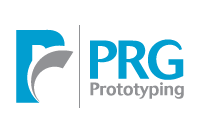Mill Work for Metal and Plastic Prototypes
The wide world of prototyping makes use of several highly specialized pieces of equipment, one of which is the milling machine. Unlike additive manufacturing—in which a product is produced by combining layers of a thermoplastic material—milling is what might be called a “subtractive” process, whereby material is milled—or removed—from a block of material to create an object. Milling is routinely utilized to create models or specific parts for testing prior to large-scale production.
PRG has recently added a new vertical milling machine to our growing collection of prototyping equipment, enabling us to expand our in-house services to include the milling of prototypes comprised of wood, metal, plastic, resin, ABS, and other materials. In turn, we can produce certain product prototypes faster than ever before, yielding reduced costs and product time to market for our customers.
Milling as Part of the Product Prototyping Process
One of many prototyping tools designed with the utmost precision in mind, our milling machine enables PRG’s prototype managers to produce molds, dies, and jigs with an unprecedented degree of accuracy. This equipment also allows us to achieve perfect hole placement and highly detailed product design when working with custom prototypes.
The process of milling is used to transform a finalized design concept into a highly realistic product comprised of materials requested by the customer. While product prototyping may use an array of specialized technologies and equipment, as a subtractive process, milling is especially useful in the confirmation of certain product development steps. Moreover, milling can be applied to virtually any material, including plastics, aluminum, steel, soft metals, exotic alloys, and wood. In turn, the customer is enabled to inspect a prototype comprised of the exact material of which the final product will be constructed.
Milling is a highly versatile process with many applications and benefits, including
- The creation of products out of aluminum, brass, zinc, tin, metal alloys, and other non-ferrous metals
- Product development with precise levels of geometrical detail
- The creation of snap-fit parts, models, tools, electronic parts, product designs, and proof-of-concepts for thermal and structural trials
- The creation of sculptural forms and wooden shapes
- The creation of parts that are virtually identical to production parts
- The creation of parts for strength, rigidity, heat, and moisture testing
- Improved time- and cost-efficiency over methods such as machining, injection molding, and casting
In short, milling empowers one to take virtually any product comprised of any material from concept to 3D model quickly, cost-effectively, and with precision.
Who Uses Milling?
Milling is employed by a diverse spectrum of industries as part of their product development and testing processes. Milling is widely used by the medical, automotive, aerospace, and military development industries, as well as among creators of consumer products. A vital step in the prototyping of many products, milling helps move end-products to the manufacturing stage and to market faster and at a lower cost than traditional methods.
PRG Prototyping specializes in the design and creation of new products, with emphases in the areas of concept design engineering, design for manufacturability, prototype development, production, and marketing presentations. PRG can also provide information on patent protection and intellectual property services. If you would like to learn more about how our newly acquired milling machine can help bring your product to life, contact us or use the following link to request a free quote.

